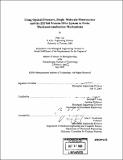Using optical tweezers, single molecule fluorescence and the ZIF268 protein-DNA system to probe mechanotransduction mechanisms
Author(s)
Lee, Peter, S.M. Massachusetts Institute of Technology
DownloadFull printable version (2.300Mb)
Other Contributors
Massachusetts Institute of Technology. Biological Engineering Division.
Advisor
Matthew J. Lang.
Terms of use
Metadata
Show full item recordAbstract
Optical tweezers instruments use laser radiation pressure to trap microscopic dielectric beads. With the appropriate chemistry, such a bead can be attached to a single molecule as a handle, permitting the application of force on the single molecule. Measuring the force applied in real-time is dependent on detecting the bead's displacement from the trapping laser beam axis. Back-focal-plane detection provides a way of measuring the displacement, in two-dimensions, at nanometer or better resolution. The first part of this work will describe the design of a simple and inexpensive position sensing module customized for optical tweezers applications. Single molecule fluorescence is another powerful technique used to obtain microscopic details in biological systems. This technique can detect the arrival of a single molecule into a small volume of space or detect the conformational changes of a single molecule. Combining optical tweezers with single-molecule fluorescence so that one can apply forces on a single molecule while monitoring its effects via single molecule fluorescence provides an even more powerful experimental platform to perform such microscopic studies. Due to the enhanced photobleaching of fluorophores caused by the trapping laser, this combined technology has only been demonstrated under optimized conditions. (cont.) The second part of this work will describe a straightforward and noninvasive method of eliminating this problem. The study of mechanotransduction in biological systems is critical to understanding the coupling between mechanical forces and biochemical reactions. Due to the recent advances in single molecule technology, it is now possible to probe such mechanisms at the single molecule level. The third and final part of this work will describe a basic mechanotransduction experiment using the well-studied ZIF268 protein-DNA system. An experimental assay and method of analysis will be outlined.
Description
Thesis (S.M.)--Massachusetts Institute of Technology, Biological Engineering Division, 2006. Includes bibliographical references (p. 42-43).
Date issued
2006Department
Massachusetts Institute of Technology. Department of Biological EngineeringPublisher
Massachusetts Institute of Technology
Keywords
Biological Engineering Division.